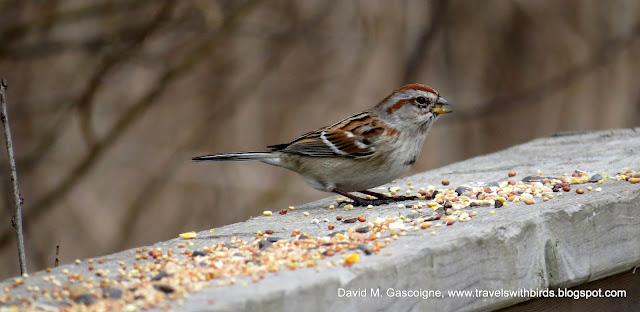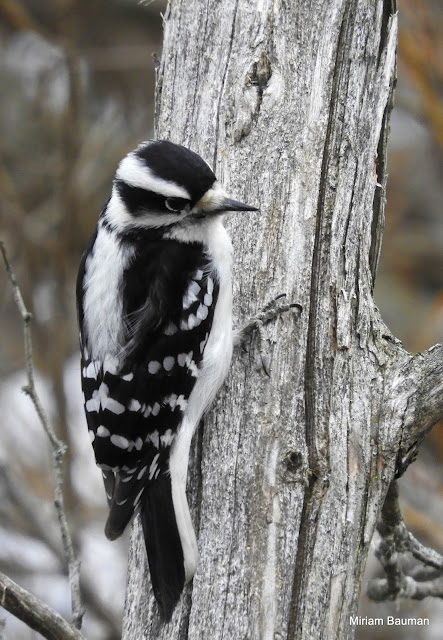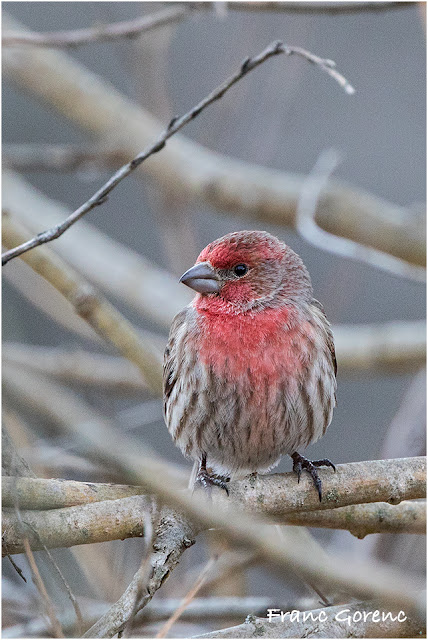06 March 2018
On all of our other jaunts to this gem of a birding spot Franc and Carol were away, so this was the first time they have been able to join us at this location. Mary was ailing a little; other than that our whole crew was together.
We are now at that time of the year when winter residents and spring migrants are present at the same time. American Tree Sparrow (Spizelloides arborea) is among the most attractive species that spends the winter here. Soon they will be moving north to their arctic breeding grounds.
A little bird seed strewed along the fence rail is guaranteed to bring them out, often accompanied by House Sparrows (Passer domesticus).
Male House Sparrows are in full nuptial regalia now and this individual was exceptionally handsome.
Dark-eyed Juncos (Junco hyemalis) are also still with us and they too will soon be leaving the area, not to be seen again until Fall.
What would a walk through a southern Ontario woodland be without a friendly Black-capped Chickadee (Poecile atricapillus) to enliven the stroll?
Of course, it is not only birds that take advantage of the handout from humans, and this American Red Squirrel (Tamiasciurus hudsonicus) wasted no time in claiming his share.
In my opinion this is one of the most attractive little squirrels in all the world.
The Speed River was swollen and flowing rapidly so there were not many species fighting the current. This pair of Common Mergansers (Mergus merganser) was the exception.
Common Grackle (Quiculus quiscula) has returned in good numbers and this fine portrait by Miriam really captures the phenomenal iridescence of the male's plumage.
The Speed River was swollen and flowing rapidly so there were not many species fighting the current. This pair of Common Mergansers (Mergus merganser) was the exception.
Common Grackle (Quiculus quiscula) has returned in good numbers and this fine portrait by Miriam really captures the phenomenal iridescence of the male's plumage.
Downy Woodpecker (Dryobates pubescens) is a very common resident and at Riverside Park it seems to be particularly emboldened, not hesitating to join the other species on the fence rail. This female was close by, descending from time to time to snatch a few seeds.
White-breasted Nuthatches (Sitta carolinensis) are similarly common and they will even feed from the hand.
Male Red-winged Blackbirds (Agelaius phoeniceus) are already claiming and defending territories, waiting for females to arrive.
There seemed to be some evidence that House Finches (Haemorhous mexicanus) are pairing off and this couple stuck together.
The males seem to be especially handsome this year.
A Red-tailed Hawk (Buteo jamaicensis) patrolled the sky, ultimately joined by a second bird, although it was unclear if this was a pair.
A Mourning Dove (Zenaida macroura) is surely one of the most delicately plumaged of our native species. It is not hard to understand why doves have always been considered symbols of peace, and have been used throughout history in myriad human rituals. So often they can be observed sitting quietly alongside each other, but they can be quarrelsome and aggressive when the occasion demands it.
There were many Northern Cardinals (Cardinalis cardinalis) present and courtship singing by males is already well advanced.
It was Francine who noticed how closely this snag resembled a bird and after she posted it to her Facebook page people had fun coming up with whimsical names.
Here are just a few: Stump Grouse, Buffy-cheeked Woodbird, Dull-brown Stump Jumper, Wooded Pecker, Willow Wood Pigeon.
Maybe you can come up with your own.
All species: Canada Goose, Mallard, Common Merganser, Red-tailed Hawk, Ring-billed Gull, Mourning Dove, Downy Woodpecker, Hairy Woodpecker, Blue Jay, American Crow, Black-capped Chickadee, White-breasted Nuthatch, American Robin, House Sparrow, House Finch, Red-winged Blackbird, Common Grackle, Dark-eyed Junco, American Tree Sparrow, Northern Cardinal
Total: 20.
All species: Canada Goose, Mallard, Common Merganser, Red-tailed Hawk, Ring-billed Gull, Mourning Dove, Downy Woodpecker, Hairy Woodpecker, Blue Jay, American Crow, Black-capped Chickadee, White-breasted Nuthatch, American Robin, House Sparrow, House Finch, Red-winged Blackbird, Common Grackle, Dark-eyed Junco, American Tree Sparrow, Northern Cardinal
Total: 20.

































Hari Om
ReplyDeleteOoh, I think you may have there the, 'Greater Speckeled Peckerwood'! All the 'portrait' shots today are outstanding. YAM xx
All birds delight me, and I was especially interested in the red-winged blackbird. The squirrel in their company is great. Regards.
ReplyDeleteBeautiful birds, David. Passer domesticus was very common here before, but now we have a lot of Passer montanus. P. domesticus have not been seen here lately.
ReplyDeleteIt seems that in many parts of Europe Passer domesticus is declining - and I am not sure that firm reasons for this trend have been established.
DeleteGood to see your band of stalwarts out there again David. After your warmer weather last week, I think we have some of it coming this way. If you were in any way responsible for this, please do the same with a Red-winged Blackbird. Or maybe post a sound track with your next photo.
ReplyDeleteHello David!
ReplyDeleteThose beautiful birds are a treat for my eyes!
Magnificent shots of the cute squirrel,the Red-Winged-Blackbird and the Downy Woodpecker that i haven’t seen before! I’m sure you enjoyed birdwatching! Have a lovely weekend!
Dimi...
Those Juncos must be a great bird to photograph in winter.
ReplyDeleteVilka fantastiska fågelbilder du bjuder på David! En helt ny fågelvärld öppnar sig för mig då alla fåglar är mer eller mindre okända för mig.
ReplyDeleteJag noterade Sitta Carolinensis som liknar vår nötväcka till viss del. Det speciella med nötväckan är att det är den enda av våra fåglar som kan klättra neråt längs en trädstam. Denna S. Carolinensis ser ut att göra just det, klättra neråt.
Och den lilla ekorren är alldeles förtjusande när den mumsar på maten.
Passer domesticus kanske är den samma som vår gråsparv. När jag växte upp var det den vanligaste fågeln av alla, den fanns överallt. Nu är det många år sedan jag sett en gråsparv. Historien berättar att gråsparven flyttade in till städerna, runt torgen där hamburgerbarer och snabbmatställen etablerades. Dålig mat för människor är dålig mat för fåglar men jag vet inte hur mycket fakta det finns i den förklaringen.
You are quite right, Gunilla, that nuthatches are the only birds to descend a tree head first and their anatomy is geared accordingly. As for the decline in House Sparrow that seems to be widespread I am sure that more than human junk food is implicated in this trend.
DeleteWhat a beautiful collection of birds, they are superb.
ReplyDeleteHi David.
ReplyDeleteBeautiful birds show you.
Beautiful in color.
The squirrel is really beautiful and fun.
Groettie from Patricia.
A real feast for the eyes, visiting today and seeing your photographs. You must be blessed with a lot of patience to capture their beauty in your shots.
ReplyDeleteReal beauty was seen :)
ReplyDeleteHello, another great outing and wonderful bird sightings. I always enjoy seeing the Tree Sparrow, they seem to be rare around here. Love the hawk in flight shot. The squirrel is a cutie. Great series of photos. Enjoy your day and weekend!
ReplyDeleteBeautiful birds, David. It is very sad that some birds are disappearing.
ReplyDeleteThe red tailed Hawk is beautiful.
Ida
Beautiful, beautiful birds... and a very cute squirrel indeed.
ReplyDeleteLovely photo of your Sitta carolinensis. Eurasian nuthatches are not very common in Finland, but I'm happy to have noticed some in the past few years.
The male house finches are really handsome! :)
As always, David, a great Tuesday walk, excellently documented and illustrated.
ReplyDeleteOn the subject of House Sparrows, whilst some birds are decidedly on the increase as garden visitors, Passer domesticus has declined dramatically in the past couple of years in our garden. At this time of year we would be seeing in the tens or twenties each day. These days it's rarely that we get more than four. It seems this decline in numbers started somewhat earlier further south, with numbers in London causing concern several years ago.
Love to you both - - - Richard
Wonderful set of photos. Sure you did not pop over to our garden for the photos of the house sparrows LOL. That log of wood is amazing. Enjoy your Sunday, Diane
ReplyDeleteHI David,
ReplyDeleteAnother successful outing with some superb images again.
What a beauty the Common Crackle is with its iridescent head.
The Northern Cardinal is always a favourite.
All the best, John
Lovely close ups of all the wildlife.
ReplyDeleteHi David,
ReplyDeleteOf all the different kinds of birds you show us here only the common merganser is familiar to me, as a well appreciated guest during the winter time. I am surprised to see the variety of species and also by the beautiful colours of some of them. The squirrel is absolutely cute.
Greetings, Kees
Hello my friend!
ReplyDeleteSo many species in one outing...
I love the Red winged and the cardinal most of all.
But the Grackle is interesting it reminds of the Rüppell Starling in Kenya.
Thanks for your fun comments, I knew my buffalo's would trigger a reaction from you! LOL!!
Abrazos amigo y un buen domingo :)
THANK YOU for finding my blog and leaving me a comment! You take the most FANTASTIC pictures. My dad was so knowledgeable about birds and wildlife of all sorts. I lost him early in life but wish I had some of his knowledge now.
ReplyDeleteI am your newest follower! Have a wonderful Sunday, David. Diana
ps- Just put you on my sidebar so I don't miss any posts- I read from there~
ReplyDeleteEstimado David enhorabuena por tan espectaculares fotos, un paseo maravilloso, muchas gracias. Un fuerte abrazo.
ReplyDeleteI was surprised by the diversity of birds that can be seen in a place with such a cold winter, with some beautiful colors, I like how they stand out in the snowy environment especially the Northern cardinal, a bird that I know since I was little in photos or in figurines. Another that I really liked was the squirrel, that in my country we only have two species that live in the jungles of the north.
ReplyDeleteSuch a fabulous collection of birds, I liked seeing the red squirrel too!
ReplyDeleteAll the best Jan
Hello, David! What fun birds in this post! I actually could identify many who hang at my feeders (including that squirrel!) I have a big squirrel with a dark tummy and one that looks like this. I chase the big one away or toss him nuts but this one can eat anywhere he chooses!
ReplyDeleteYeah, I know -- that flying bird in my post was a crane, not a pigeon. But it was the only flying bird in the song lyrics and I figured I'd live with the consequences! (I think you were the only one who noticed, so whew! I would have expected no less!)
And yes, should Rick and I get to your area, it would be great fun to tip a glass of wine, with great bread and cheese of course. The same goes for you -- should you happen across the border!
Wow those colours of some of the birds you saw are just stunning. Good to see they get some extra food to go trough the last days of Winter.
ReplyDeleteGreat blog.
Regards,
Roos
So beautiful birdphotos! Common Grackle and Red-winged Blackbirds looks so exotic to me. And Squirrels are always cute.
ReplyDelete